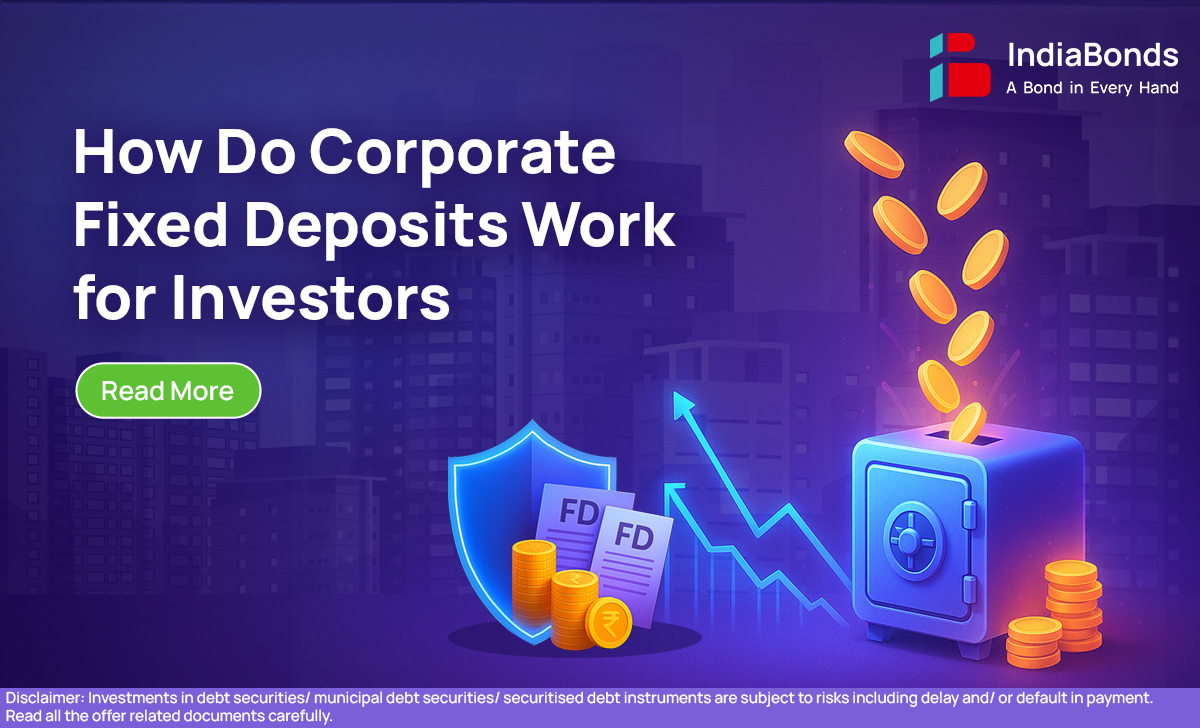How Do Corporate Fixed Deposits Work for Investors?

For generations, Indian savers have relied on the familiar comfort of bank fixed deposits (FDs). They are simple, secure, and a cornerstone of conservative investing. However, in a world of rising aspirations, many investors find themselves asking: “Can my money do more?” If you’re looking for a way to earn higher returns without straying too far from the principles of fixed-income investing, corporate fixed deposits present a compelling alternative. They operate on a similar foundation to bank FDs but offer an enhanced yield in exchange for a calculated risk. This guide will walk you through exactly how corporate FDs work, who they are for, and how you can make them a smart addition to your investment portfolio, balancing the quest for better returns with the need for financial prudence.
What Are Corporate Fixed Deposits?
At its core, a corporate fixed deposit is a direct loan you provide to a company for a predetermined period at a fixed rate of interest. Instead of seeking loans from banks, corporations—including Non-Banking Financial Companies (NBFCs) and other manufacturing or service firms—raise capital directly from the public. You, the investor, deposit a lump sum with the company for a specific tenure, ranging from a few months to several years. In return, the company pays you regular interest and repays the principal amount upon maturity. The crucial difference lies in the underlying security. Bank fixed deposits in India are insured by the Deposit Insurance and Credit Guarantee Corporation (DICGC) for up to ₹5 lakh. Corporate FDs, on the other hand, carry no such government-backed insurance. Their safety is entirely dependent on the financial health and creditworthiness of the issuing company, which is why they offer higher interest rates to compensate for this additional risk.




How Do Corporate Fixed Deposits Work?
The process of investing in a corporate FD is straightforward and systematic. It begins with you, the investor, identifying a company whose FD scheme aligns with your financial goals. The journey typically follows these steps:
Research and Selection:
An investor first evaluates various companies based on their credit ratings (assigned by agencies like CRISIL, ICRA), financial stability, and past performance in honoring debt obligations.
Application and KYC:
Once a company is chosen, you fill out an application form, either online or offline, and complete the Know Your Customer (KYC) process by submitting required identity and address proofs.
Investment:
You then invest your desired amount via cheque or online transfer.
Confirmation:
After the company processes your application and funds, it issues a Fixed Deposit Receipt (FDR). This document is proof of your investment and contains all critical details like the principal amount, interest rate, tenure, and maturity date.
Interest Payouts:
You can choose between cumulative and non-cumulative options. In a non-cumulative plan, interest is paid out at regular intervals (monthly, quarterly, etc.). In a cumulative plan, the interest is reinvested and paid along with the principal at maturity, allowing your wealth to compound.
Maturity:
Upon completion of the tenure, the company repays the principal amount and any accrued interest directly to your bank account.
Benefits of Corporate Fixed Deposits
Corporate FDs offer several advantages that make them attractive to investors seeking to optimize their debt portfolio.
Higher Interest Rates:
Their most significant draw is the potential for higher returns. Corporate FDs typically offer interest rates that are 1% to 3% higher than those offered by traditional bank FDs, leading to better wealth creation.
Flexible Tenure Options:
Companies offer a wide range of tenures, usually starting from 12 months and going up to 7 years or more, giving investors the flexibility to align their investments with specific financial goals.
Regular Income Stream:
The non-cumulative payout option is an excellent tool for generating a steady and predictable income stream, making it particularly beneficial for retirees or those needing regular cash flow.
Reputable Issuers and Credit Ratings:
While risk exists, you can mitigate it by investing in FDs from highly-rated companies (e.g., AAA or AA rated), which have a proven track record of financial stability and are considered to have a very low risk of default.
Risks Involved in Corporate Fixed Deposits
While corporate fixed deposits can be rewarding, it’s important to understand the risks before you invest:
Default Risk: Unlike bank FDs, corporate FDs are not backed by insurance. If the company faces financial trouble or goes bankrupt, you may lose your money. This makes it essential to pick companies with strong credit ratings and consistent performance.
Liquidity Risk: Corporate FDs are usually less flexible if you need your money before the maturity date. Some companies may refuse early withdrawals altogether, while others might charge penalty fees, reducing your returns.
Interest Rate Risk: If general interest rates in the market go up after you’ve invested in a corporate FD, you’re still locked into the original rate for your entire tenure. This means you could miss out on better earning opportunities elsewhere. To manage these risks, always invest in well-known, financially healthy companies with top credit ratings. And remember, spreading your money across different companies and keeping some savings in liquid assets can help balance out potential downsides.
Who Should Invest in Corporate FDs?
Corporate fixed deposits may be a good fit for investors who want a bit more from their fixed-income investments. If you’re comfortable taking on a slightly higher risk than with bank FDs, and you’re looking for returns that often outpace those of traditional FDs, these could be worth considering.
They’re especially useful if you want to diversify your investment portfolio beyond just bank deposits and stocks. Investors seeking flexible payout options—like monthly or quarterly interest for regular expenses—or those with medium-term financial goals may also find corporate FDs appealing. Just remember, these are best suited for people who check company backgrounds, are clear about the risks, and don’t need instant access to their cash at all times.
Taxation on Corporate Fixed Deposits
The interest earned from corporate fixed deposits is fully taxable and is treated as ‘Income from Other Sources’ on your tax return. It is added to your total income and taxed according to your applicable income tax slab. As per current regulations, if the interest income from a single company exceeds ₹5,000 in a financial year, the company is required to deduct Tax at Source (TDS) at a rate of 10% (if your PAN is provided). It’s important to note that even if TDS is deducted, you are still liable to pay the remaining tax if you fall in a higher tax bracket (20% or 30%). Conversely, if your total income is below the taxable limit, you can submit Form 15G (for individuals below 60) or Form 15H (for senior citizens) to the company to request that TDS not be deducted.
How to Choose the Right Corporate FD?
Choosing the right corporate FD requires due diligence beyond simply comparing interest rates. A higher rate often signifies higher risk. The most critical factor to check is the credit rating assigned by agencies like CRISIL, ICRA, or CARE. A rating of AAA or AA indicates a high degree of safety regarding timely payment of interest and principal. You should also investigate the company’s financial health by reviewing its balance sheet and profit and loss statements. Look for consistent profitability and manageable debt levels. It is also wise to consider the company’s parentage and group reputation, as a strong promoter group can offer an additional layer of comfort. Finally, read the terms and conditions carefully, especially those related to premature withdrawal, to ensure they align with your liquidity needs.
Key Differences Between a Bank FD and a Company FD?
While both are fixed-income instruments, there are fundamental differences between a bank FD and a company FD. The primary distinction is safety. Bank FDs are protected by DICGC insurance up to ₹5 lakh, making them virtually risk-free for that amount. Company FDs offer no such protection and carry a credit risk, meaning if the company defaults, you could lose your entire principal. The second difference is returns. To compensate for the higher risk, company FDs offer higher interest rates. The third difference is the issuer. Bank FDs are issued by regulated banking institutions, whereas company FDs are issued by a variety of entities, including NBFCs and manufacturing firms. Lastly, liquidity can differ. Bank FDs often have more straightforward and less punitive options for premature withdrawal compared to corporate FDs, which may have stricter lock-in periods and higher penalties.
Things to Keep in Mind Before Investing
Before you invest in a corporate FD, it’s crucial to be mindful of a few key considerations. First, do not let a high interest rate be your only deciding factor. A rate that seems too good to be true might be a red flag for underlying financial instability. Second, thoroughly understand the rules regarding premature withdrawal. Many corporate FDs have a mandatory lock-in period (e.g., 3-6 months) during which you cannot withdraw, and even after that, the penalties can be steep. Third, always diversify your investments. Never put all your savings into the FD of a single company, no matter how reputable it seems. Spreading your investment across multiple companies mitigates the risk of a significant loss if one company faces financial trouble.
Conclusion
Corporate fixed deposits occupy a valuable space in the investment landscape, offering a middle path for those who want more from their money than bank FDs can offer but wish to avoid the volatility of the stock market. They provide an opportunity for higher returns, regular income, and portfolio diversification. However, these benefits come with inherent credit and liquidity risks that cannot be ignored. The key to successful investing in corporate FDs lies in thorough research, a focus on high-quality and well-rated companies, and prudent asset allocation. When used wisely as part of a diversified portfolio, they can effectively boost your overall returns and help you achieve your financial goals faster.
FAQs
1. What documents are required to invest in corporate fixed deposits?
You’ll typically need basic KYC documents such as a PAN card, proof of identity (like Aadhaar or passport), proof of address, and recent passport-sized photographs. Some companies may ask for additional documents based on their requirements.
2. What is the difference between cumulative and non-cumulative interest payouts?
In a cumulative FD, the interest is compounded and paid to you only at maturity—great for those wanting to grow their investment. In a non-cumulative FD, interest is paid out at regular intervals (monthly, quarterly, etc.), making it better for people who need regular income.
3. Are the interest earnings from corporate fixed deposits taxable?
Yes, all interest earnings from corporate FDs are taxable according to your income tax slab. If the annual interest from a single company goes above ₹5,000, TDS will be deducted.
4. What is the minimum amount required to invest in corporate fixed deposits?
The minimum investment amount varies from company to company but typically starts from ₹10,000 or ₹25,000, making it accessible for retail investors.
5. Is it good to invest in corporate FD?
Their safety depends on the credit rating and financial health of the issuing company. FDs from companies with high ratings (like AAA or AA) are considered relatively safe, but they are not risk-free and do not come with any government insurance like bank FDs.
6. Is corporate FD interest taxable?
Yes, the interest earned is fully taxable under the head ‘Income from Other Sources’ and is taxed as per your individual income tax slab.
7. What is the difference between a bank FD and a company FD?
Bank FDs are issued by banks and insured up to ₹5 lakhs by the government, making them safer. Company FDs, or corporate FDs, are issued by companies or NBFCs, offer higher returns but come with higher risk as there’s no government guarantee.
Disclaimer : Investments in debt securities/ municipal debt securities/ securitised debt instruments are subject to risks including delay and/ or default in payment. Read all the offer related documents carefully.



















































